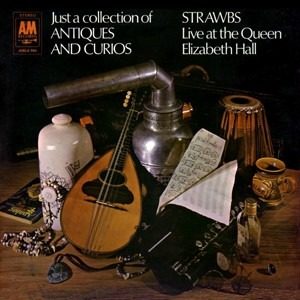Just A Collection of Antiques and Curios – A review by Aaron Badgley
Just A Collection of Antiques and Curios
Release date: October, 1970
A & M AMS 994 (U.K.)
A & M SP-4288 (North America)
CD Reissue: 2008
Universal 540 938-2
The third time’s the charm.Or so they say, but for Strawbs, this was the case. This is their first album to chart (peaking at number 27 in the U.K.), their first live album, and their first worldwide release. The fact that their North American debut album was a live album was also not the norm, but then, when did Strawbs ever do the expected.
By the summer of 1970, the band had been through some changes. Ron Chesterman left, and Cousins and Hooper recruited Rick Wakeman (organ, piano, celeste, harpsichord), Richard Hudson (congas, percussion, sitar, vocals) and John Ford (bass, vocals). There had been other minor changes since Dragonfly, but this is the lineup that hit the stage at London’s Queen ELizabeth Theatre on July 11, 1970. And with one exception, the band played new songs.
The one exception is “Where Is The Dream Of Your Youth”, a three minute pop song from their debut album (Strawbs) transformed into a nine minute prog rock road map for future bands. Seriously, I am convinced that a great many prog bands studied this fantastic live version and it became the blueprint of what was to come for Strawbs and a great many other bands.
Tony Visconti was, once again, in the producer’s chair and he captured a young and on their incline. The choice to record the band live was genius. This is one of the best live albums ever recorded and released. Here is a young band, a new lineup and new songs being showcased very early in their career and yet they play like seasoned professionals. They are so tight and the playing is near flawless that at times you might forget you are listening to a band live on stage.
The album opens with a more folky “Martin Luther King’s Dream”. Cousins vocals and playing is stunning and although it is the shortest song in the set, it packs a powerful punch. It is a song of its time, and yet is timeless. This is an example of Cousins being able to sum up a great deal in few words.
This leads nicely into the multipart “The Antique Suite”. This features four distinct pieces and Cousins is able to blend it all together. The songs fit together and it is a good example of bridging folk into prog rock. A brilliant song. Rick Wakeman’s “Temperment Of Time” completes side one in a stylish manner. A wonderful piece.
Side two begins with the wonderful “Fingertips”, where Ford’s bass is allowed to shine. He demonstrates a solid beat with melody throughout this six minute opus. Hudson plays some beautiful sitar and the song just builds and builds. It really is quite sublime.
Up next, “Song Of A Sad Little Girl”, the song that I would say is the highlight of the album. Between Wakeman’s piano and Cousin’s voice (and lyrics), one is treated to an incredibly moving experience. When this was reissued on CD in 1998, the song was restored to its original in concert length, which makes the song even better. The original album ends with the previously mentioned “Where Is The Dream Of Your Youth”.
Although no singles were released from the album, Strawbs did release “Forever” in July. This wonderful song was added as a bonus track on the 1998 CD reissue. It is the only studio track on the CD. Two previously unreleased songs from the concert, “The Vision Of The Lady Of The Lake” and “We’ll Meet Again Sometime” we are also bonus tracks on the CD reissue. Both songs are welcome additions, and perhaps one day an extended version with the complete concert will be released
Many of these songs have been performed in concert and many excellent live records are available. Cousins performs a stirring version of “Song Of A Sad Little Girl” on his Secret Paths album a beautiful version of “Martin Luther King’s Dream” on Wakeman and Cousins ‘Live’ – From The Witchwood Archives Series: Vol. 1.
Just A Collection of Antiques and Curios is a brilliant album, and for many, it served as an introduction to Strawbs. And what a fine introduction it is. It stands the test of time, and sounds as fresh today as it did in 1970. It was also a clear indicator that bigger things were on the way.



